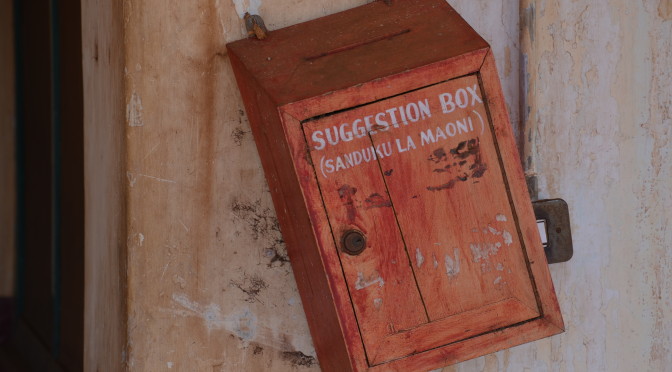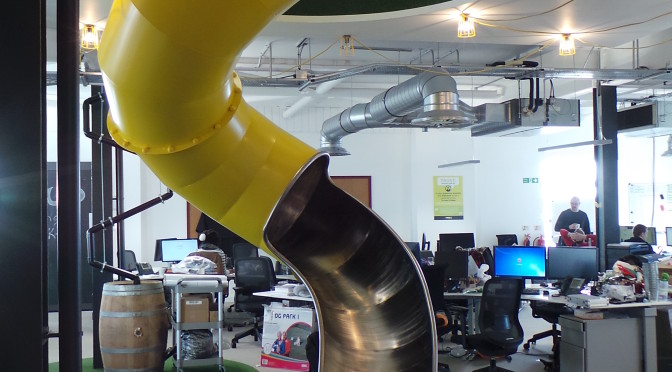The keys to successful change in an organization are well known:
- Involve those affected
- Have a clear purpose
- Listen to concerns
So why do so few follow this?
Leadership is an insanely important discipline. Here you’ll find the thought, tools and tricks of the trade of great leaders.
The keys to successful change in an organization are well known:
So why do so few follow this?

The worst accident in the history of aviation happened on the Spanish Island of Tenerife on March 27 1977 when a KLM 747 taking off crashed into a Pan Am 747 that was still on the runway.
A long chain of events led up to the crash, but one of the major causes was that the captain of the KLM flight chose to ignore a crucial warning from his co-workers in the cockpit.
The KLM captain was no novice – in fact he was one of KLM’s most experienced pilots, the head of pilot safety training at KLM and featured in some of the company’s ads.
On the day of the crash the flight was already significantly delayed and any more delays would have forced the plane to stay on Tenerife overnight to comply with pilot rest requirements.
The captain, being eager to get off the ground, misheard an instruction from the control tower. He thought he was cleared for take off even though another plane was still on the runway, though he couldn’t see it in the heavy fog.
Then, and this is crucial, he ignored concerns from both his co-pilot and his flight engineer and proceeded to take off down the runway, eventually hitting the other plane. 583 people died.
As a result, “less experienced flight crew members were encouraged to challenge their captains when they believed something was not correct, and captains were instructed to listen to their crew and evaluate all decisions in light of crew concerns” (source).
This is obviously a horrific example but the learning that applies to all workplaces is that much is gained if:
However, the implicit power imbalance between employees and managers means that this is not something people do automatically. You have to explicitly train both of these aspects in order to make sure that it becomes part of the corporate culture.
There are three reasons why a company should do this.
If the KLM captain had listened to his subordinates that accident would have been avoided.
How many accidents, mistakes and errors are allowed to happen daily in workplaces around the world because employees are too intimidated to disagree with the boss or are ignored when they do so?
I recounted that story with great sadness, as it had been agonizing to watch my patient suffer through treatments that I believed he would not have chosen had he known the harm they could cause and the unlikeliness of being cured.
He eventually was admitted to hospice and died, but only after the chemo had left him with unstoppable and painful bleeding in his bladder, robbing him of a more peaceful and more comfortable end to his life.
This is from a NYT story written by a nurse who believed that one of her patients was receiving an unnecessary and incredibly painful round of chemo. She raised her concerns to a doctor and was promptly ignored. Reading the story makes it clear that this made her unhappy. Not only was her patient suffering needlessly but her expertise and judgment was being ignored.
The nurse goes on to write this:
Many of the nurses I know could share their own, dramatic stories of rescuing patients or catching frightening errors by other health care workers, including doctors.
And finally, giving employees permission to disagree and managers the obligation to listen and act on disagreement could help weed out those managers who are pathologically incapable of ever admitting error or admitting that they might not know everything already.
That kind of boss is endemic (and is even celebrated in many workplaces) but is ultimately incredibly damaging to business results.
Furthermore, when managers keep screwing up, it’s usually up to employees to keep fixing their mistakes and dealing with the fallout which clearly makes people frustrated and unhappy at work.
There are plenty of articles out there with tips on how to disagree with your boss but most of them suffer from one fundamental problem: They take it as a given that the boss has the power, and therefore it is the responsibility of the employee to raise their disagreement in a respectful way that doesn’t bruise the bosses ego.
Also, many bosses see disagreement from subordinates as a sign of disloyalty and disrespect. Of course, nothing could be further from the truth. Disagreeing with what you see as a bad decision is in fact a sign of engagement and bosses should learn to appreciate that.
So I say we should turn that around and create workplaces where anyone is free to disagree with anyone else.
And this should apply not only to imminent mistakes but also to workplace practices, workloads, task assignments – everything. Every time you as an employee see something you disagree with or think is wrong you should be able to speak up and know that your concerns will be taken seriously.
Are you free to disagree with your boss at work? Will your boss listen? What if you can see your workplace doing something silly or wrong – do you know how and when to raise that?
A journalist once asked me why employees put up with bad bosses.
Without thinking about it I blurted out “Stockholm syndrome.”
I later realized I may have been right.
I’ve previously written about US online retailer Zappos and what makes them such a happy workplace.
In this video I talk to their Director of HR Hollie Delaney and Jamie Naughton who is Speaker of the House and we especially focus on the Zappos culture which permeates every aspect of running the company.
I also ask them how weird they are – but there’s a point to that :-)
 Yesterday I made a massive mistake that was both awkward, stupid and painful.
Yesterday I made a massive mistake that was both awkward, stupid and painful.
I had a really important meeting with a large group of people from a client – and somehow that meeting wasn’t in my calendar. The meeting was at 1 o’clock, which I found out when one of them called me at 1:05 to ask where I was.
And this is not only a big client, this was the kick-off meeting for that project, and I forgot to go. I felt awful.
But then I remembered my own advice about celebrating mistakes.
Everyone makes mistakes at work. But rather than hide them and be embarassed, it is much better to celebrate your mistakes with others.
So let me reframe that: WOOHOO – I forgot a meeting.
This is not to say that I take forgetting my commitments lightly or that I plan to miss more meetings.
This is simply to say that mistakes are inevitable – the key thing is to learn from your mistakes, so you don’t have to make the same ones over and over. Instead, you can move on to make bigger and better mistakes.
As Samuel Beckett put it:
Ever tried.
Ever failed.
No matter.
Try again.
Fail again.
Fail better.
I have rescheduled the meetings with the client who took it very nicely and I do plan to be there this time. I may even bring cake to celebrate my mistake :-)
Got a mistake you’d like to celebrate? Share it in the comments.

Almost every company talks about empowering their employees, but few actually do it an any meaningful way. In many cases it becomes a sham process, where employees are encouraged to voice their opinions and those opinions are then promptly ignored.
And the best (or is that worst) symbol of fake empowerment is the suggestion box. Many workplaces have one hanging on a wall somewhere. You can stick in your idea, but then what? Who (if anyone) will read it? Will it ever be acted upon? If not, why not? If it is, who will take credit?
It’s time to kill off the suggestions box and the coolest way I’ve seen to do this comes from marketing agency Quirk based in Cape Town, Johannesburg and the UK.
They have created a process that let’s anyone in the company suggest ideas, gather support for them and then have them implemented (or not). When I visited their Cape Town HQ I had a chance to see it for myself, and I think every workplace who wants to give their employees a voice should do something similar.
This flowchart shows how it works:

The first step is to post your idea to a board that hangs in a prominent spot in the office and get 12 of your coworkers to also sign on. If you like an idea, you show your support in a very low-tech way: you put a sticker on it.
Some ideas die at this stage – there’s just not enough energy or support behind the proposal. All ideas that don’t make it for one reason or another are displayed in The Graveyard:
Here you can see each idea that failed and why.
If an idea does get the necessary support, the person behind it writes a one-page proposal which is then submitted to Quirk’s EXCO, which is basically their top leadership team.
If they approve it, the idea goes ahead immediately and is placed on the “Ideas in motion” section of the board:
Ideas that were previously approved are shown on the “It’s happening” section.
Of course, the leadership group can turn the idea down, and if they do, they must carefully explain why they don’t think it’s a good idea. They can’t just say “No” or “Maybe later.”
But as you can see from the flow chart above, even if the leadership group turns an idea down, that need not be the end of it. If a person feels that this idea is still to good to ignore, it can be put to a debate and subsequent vote inside the company. If the idea is voted through, this overrides the EXCO’s decision and the idea goes ahead anyway.
Another thing they do on the board is highlight the costs of previous ideas, so employees know how much things end up costing.
I think this process is absolutely brilliant for 5 reasons:
1: It’s visual
It’s not just a bunch of documents or lines in a spreadsheet – this is highly visual which gives you a great overview. It’s also well-designed and looks pretty, which probably helps a little too.
2: It’s low-tech
This could also be done on the intranet or in an app, but I kinda like that it’s on paper and cork board and you vote with stickers. This also makes it very flexible. Also, a page or an app is on demand – that means that people need to be proactive to access their democracy (and apathy is a killer). This board is a sort of dynamic wallpaper – it sits in front of your eyes while you butter your toast in the kitchen – you can be as passive as you like – the democracy comes to you.
3: It’s fast
The process is fast. The leadership group have committed to addressing each idea at their next meeting and this means that ideas can get acted on while the energy is still there.
4: It has memory
The board is a great record of previous failed ideas (so you don’t have to deal with the same proposals once every 6 months from different people and it also highlights ideas that were implemented, so you can see that this actually works.
5: It’s transparent
This takes most of the politics out of these ideas. Getting your idea implemented is not about who you know or how well you can lobby for it, it’s about gaining support for good suggestions.
There is zero doubt that autonomy and control over our own situation makes us happy. The more we can meaningfully contribute to things we care about at work, the prouder and happier we feel. And that way the company can also better tap into the creativity of its employees and become more efficient.
So simply put:
Fake empowerment = frustration and cynicism.
Real empowerment = trust and happiness.
Does your workplace empower its employees? For real or in a fake way? If you have a really good idea, do you know where to go with it?
Photo credits: The awesome picture above of the suggestion box is from a train station in Moshi, Tanzania and was originally shown here. All other photos are courtesy of Quirk.

Last week when I was in London I met Gaye Andrews who is Head of Customer Service, EMEA at PEER 1 Hosting and very much the woman behind creating a great workplace.
She shared a cool policy they have: Any employee who has an idea to make work more fun or the office a little more cool that costs less than £100 can just do it and expense the amount.
As an example, that’s how they got space hoppers.
I think it’s a cool idea, that can remove layers of bureaucracy and get employees involved in making the workplace better and happier.

I just got one of my favorite kinds of emails – from a company who is doing something to create a happier workplace.
Dean Stainton who is the Director of Client Services and People Systems at NRI Distribution in Canada wrote:
I wanted to reach out to you and let you know about a couple of things.
I had the fun of meeting you at the Worldblu Live Conference in Denver and attending your session on workplace happiness. As a result of that experience I decided to try something when I got back to our work environment.
I am very fortunate that I have accountabilities on both the HR and the Client Services side, knowing that getting 12 customer service reps onside with workplace happiness would be far more difficult than 4 HR people I decided to give it a try and tackle Workplace Happiness with the 12.
I bought copies of the book for everyone (Happy Hour is 9 – 5) and everyone took some time to read it on their own. After reading the book we discussed it in our weekly meeting (which has been named Happy Hour!) and each Client Services Rep and myself were left with three questions to answer:
- What can you do to make NRI a happier place to be?
- What can we do as a team to make NRI a happier place to be?
- What is stopping you/us from doing the answers to the above?
Those are some great questions and Dean’s group came up with plenty of ideas and have implemented two already.

One is a Praise Window at Dean’s office (erasable markers are available at the window and coworkers write down good things about each other for everyone to see). Dean writes:
No matter what people have written they are doing it with a smile on their face and typically a little giggle. Everyone who comes by stops to have a read and all either smile or laugh too….it is really contagious (but you already knew that). It has gotten to the point now where people in the warehouse are talking about doing the “praise window”. It has been particularly neat to see this coming from the Client Services side, as people have typically expected things like this from our HR team.
Someone else suggested “sharing the love,” writing:
I know that every now and then I get an email from a client who is super stoked about something. Most of the time I’m just happy that they’re happy and delete the email. Recently I forwarded one of these emails to Ops to SHOW them that the client was happy with the work they had done. This is praise coming directly from the client, and not just boring old me who says “yay! Thanks!” all the time. I think it was awesome for them to see, and made them feel good about their work! I know this isn’t something that happens often, but when it does…..share it!
Dean sums the whole thing up like this:
The ideas and enthusiasm have been amazing and once realizing that they didn’t need anyone’s “permission” to do cool, fun things it has been contagious.
And this is the team doing it, not the Manager asking them to do it!
We are very early in our journey but wanted to let you know the impact that your insight and passion have had on our team. I anticipate that the next time I send you an email it will have expanded past the Client Services Team. Thanks Alex!
What I really like about this is two things:
If I’ve said it once I’ve said it a thousand times: Happiness at work is something we do.
I suggest you find a way to ask some of the same questions in your workplace and if you come up with something cool, please tell me about it :o)
“Study finds that basically every single person hates performance reviews.”
That’s the headline for this new Washington Post article and I couldn’t agree more.
In fact, I’ve written about this previously. Here are the Top 10 Reasons Why Performance Reviews Don’t Work.

I recently had a chance to visit PEER1 hosting in Southampton in southern England and talk to their CEO Dominic Monkhouse about their culture.
PEER1 does hosting for big web sites and have around 120 employees in the UK. They have a very clear vision for creating customer happiness, and have realized that this is only possible when you have happy employees.
There are many cool aspects of their culture (here’s an excellent video where Dom explains it), but the most visible is how cool their office space is. First of all, it’s on the docks in Southampton with beautiful views over the water – but they’ve also gone out of their way to introduce many great-looking, fun and functional elements.
Here are my photos from a seeeeeriously cool workplace.









